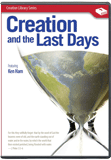News to Note, April 14, 2007
A weekly feature examining news from the biblical viewpoint
1. Marrow from a Rex
It was news that rocked the world of paleontology two years ago: molecular paleontologist Mary Schweitzer and her colleagues reported the discovery of “soft, stretchy” tissue in a T. rex fossil believed to be 68 million years old. Incredibly, Schweitzer and other paleontologists have fiercely held on to their old-age beliefs, concluding that soft tissue must be able to survive such a long period, rather than admitting that the old-earth paradigm is flawed.
2. National Geographic News: “Chimps Use Caves to Beat the Heat, Scientists Find“
Chimps use caves; therefore, evolution is true-at least, that’s the tone of news reports this week that describe cave habitation by chimpanzees living in West Africa. In a behavior that “appears to be an adjustment to heat stress” during the “end of the dry season in May and June,” the chimpanzees seek shelter in the relatively cool caves. Such behavior has been observed, but not amply documented, in other chimpanzee populations, says Jill Pruetz, the anthropologist who led the research. And, of course, this discovery is interpreted as an important evolutionary milestone:
The adaptations of savanna chimpanzees are particularly interesting to researchers because early humans are thought to have occupied similar environments.
Based on illogic like this, when a primate is seen doing anything remotely human-like, it is dramatically paraded by evolutionists as a sign of our kinship with apes. And what should we expect? After all, evolutionists presuppose the evolutionary connection between apes and humans, so why shouldn’t they interpret similarities as signs of our supposed joint ancestry?
William McGrew of Cambridge University best represented the evolutionary interpretation of these chimps’ pedestrian behavior: “This is one of those cases in which the apes genuinely surprise us, exceeding our expectations and imaginations.” The creationist interpretation, we’re afraid, is quite a bit more boring (indeed, it is unsurprising, does not exceed expectations, and does not inspire the imagination): the chimps were hot and sought refuge in caves, proving evolution no more than a dog cooling off by jumping into a swimming pool.
3. Pope Benedict: Theistic Evolutionist
For the first time in his papacy, Pope Benedict has “elaborat[ed] his views” on human origins. Although his statements do not alter Rome’s overall stance on evolution, his comments are more distant from the late John Paul II’s tacit endorsement of evolution as God’s creative method.
4. Wanted: One Planet, With Water
Since evolutionists believe adding time, chance, and the right ingredients together results in life, in recent years we have seen an accelerated search for planets that have such “right” ingredients. Thus, this week’s report of the first sign of planetary water outside our solar system has some evolutionists nearly giddy-but others remain skeptical.
5. Inerrant In and About All
“At Newsweek‘s invitation” last week, well-known pastor Rick Warren, author of The Purpose-Driven Life, debated “new atheist” Sam Harris. For the most part, the debate is what one might expect; neither “side” seems to budge in its own position, instead merely reciting the common arguments surrounding the debate over religion and theism.
6. LiveScience: “Before They Fly, Spiders Check the Weather“
Stunning examples of God’s awesome capacity for design abound all around us-even in the lowly spider! Research published recently in Biology Letters explains how spiders take to the air, “flying” by “casting out a ‘dragline’ of silk thread, which gets carried by the wind, along with the attached critter.” But the truly amazing aspect of spider flight, as reported in the research, is how spiders determine “the best flight weather” before casting their lines. Spiders are most likely to “soar” on cloudy fall and spring days, avoiding breezeless summer days as well as the other extreme, stormy and wintry conditions.
This is where the design aspect comes in; after all, spiders lack the tools available to meteorologists! But as lead study author Andy Reynolds explains, “The literature on spider sensing points to tarsal organs and hairs as having roles in, respectively, the detection of temperature and wind speed.” While evolutionists wonder how such an integrated weather-determining system would have evolved, creationists can recognize the wonderful mechanism as part of God’s design.
For More Information: Get Answers
Remember, if you see a news story that might merit some attention, let us know about it! (Note: if the story originates from the Associated Press, FOX News, MSNBC, the New York Times, or another major national media outlet, we will most likely have already heard about it.) And thanks to all of our readers who have submitted great news tips to us. If you didn’t catch all the latest News to Know, why not take a look to see what you’ve missed?
(Please note that links will take you directly to the source. Answers in Genesis is not responsible for content on the websites to which we refer. For more information, please see our Privacy Policy.)
Recommended Resources

Answers in Genesis is an apologetics ministry, dedicated to helping Christians defend their faith and proclaim the good news of Jesus Christ.
- Customer Service 800.778.3390
- © 2024 Answers in Genesis



